Now that we’re two weeks after the launch of Will It Fly?, I’m stoked to be able to share even more details with you about how it was all put together. Coming in March, you’re going to see a massive post with all of the ins and outs of every part of the process, but in this post, I wanted to do a couple of things for you:
1) Share the social media strategy we used, which played a critical role in helping to spread the word, and
2) Introduce you to someone new on my team. He’s been helping me for a while, but you likely didn’t know about him. His name is Non, and he’s awesome. He helped to lead the social media push on Will It Fly.
Because I was busy last week at the Traffic and Conversion Summit, he volunteered to write up this post, and I thought it was the perfect opportunity to introduce him to you, and also share some massive value at the same time.
So without further delay, take it away Non!
Hello!
My name is Non, which is pronounced like “known” and routinely described, by me, as being a product of hippie parents.
Pat Flynn, to my knowledge, is not a hippie. Pat is an inspiring, hard working, wholehearted human, and (as you probably know) the author of Will It Fly?: How to Test Your Next Business Idea So You Don’t Waste Your Time and Money, which was just released on February 1!
Will It Fly?, as Pat says in its introduction, is a book that was written for you, the person with the neat business idea, “to help you build your wings, and visualize your flight path.”
I led the social media strategy for Pat’s book promotion and launch. As a team, we thought that you would enjoy a behind-the-scenes tour of our strategy so that you may be able to replicate some aspect(s) of it when you launch your next thing.
So that’s what this post is about—the social media strategy Team Flynn created to effectively support a coordinated, multi-platform social media effort to promote the Will It Fly? launch. I’m excited to share with you how we built our strategy, what worked, and how it worked.
Step 1: Determine Goals for the Will It Fly? Social Media Strategy
Determining our goals was the logical starting point for our social media strategy. We needed to know where we were headed, and we needed to have a solid understanding of the outcome when we got there. Without the goals, we would’ve been lost. Not like lost in the woods, starved, contemplating-eating-your-hiking-companion type of lost. But certainly lost enough to provide confusion, inefficiencies, redundant efforts, and a non-deadly snake bite or two.
Point being, we needed to be as clear about our social media strategy as we could be, being mindful of desired outcomes, and fully engaged with the most logical path to achieve those outcomes.
We focused on three key goals:
- Nurture as large of a focused pre-launch audience as possible
- Educate potential readers on the value proposition of Will It Fly?
- Diversify the awareness of Will It Fly? to the greatest extent possible
United together like Voltron, defender of the universe, our three goals formed the singular force we needed to succeed. We had a cohesive fanbase that knew enough about Pat’s book and cared enough about its message to advocate for it across multiple social media channels in a coordinated movement so as to maximize launch momentum come publication day.
How do you bring these goals to life? With strategies that match the focus, tone, and desired outcome of the goals themselves. And in the land of strategies, more isn’t always better.
Step 2: Develop a Few Critical Strategies
In social media, there are countless strategies to choose from and adapt in some fashion. Thus, our challenge was to zero in on a critical few that aligned with our goals and, ultimately, the overall message of Will It Fly?
We collaborated a lot as a team to whittle down the options and arrive at the critical strategies we thought best for the campaign. Our choices didn’t only have the positive effect of focusing our operational plans; they also informed the type of content we published.
Our strategies were:
1. Publish engaging, value-add content that promotes the book’s message and reason for existence.
Keeping our goals in mind, we developed in-depth content engagement ideas. Specifically, we thought Twitter content could serve as a base of content generation. Once that content was crafted we could then extend it naturally to other social media platforms. This approach proved to be very effective because Twitter forced us to keep this simple at the start and then expand and enrich them for other channels like Facebook, Periscope, and Goodreads.
Our initial brainstorm of content ideas ended up like this:
- Will It Fly? book launch date
- Will It Fly? launch party webinar signup
- Behind the scenes of writing Will It Fly?
- Will It Fly? book trailer
- Snippets of advance reviews of book
- Images (the final book cover (in full, or only a piece of it as a teaser), the preliminary concepts, book covers that were inspirations, etc.)
- Thanks to advance reviewers
- Will It Fly? hashtag: #WillItFly
- Inspiring, single-line quotes from book
- Relevant application of book to the lives of your audience
- Guest blog posts on Will It Fly?
- Will It Fly? fun facts (e.g., number of hours spent writing the book, fun juxtaposition tweets about how the “it” will fly but elephants may not, etc.)
- “The Daily Update” about the book campaign/project
- Any other “exclusive” content that we may be able to drip out
- Retweets from fans about Will It Fly & from #WillItFly hashtag
- Live tweeting during launch day webinar
- Tweet to announce Periscope appearances
If you analogize these brainstorming ideas as elements on the Periodic Table, then putting them in action was an act of chemistry. (Science!) Different combinations of elements yielded different types of content that we could publish. Here are some examples that emerged from our lab of content chemistry:
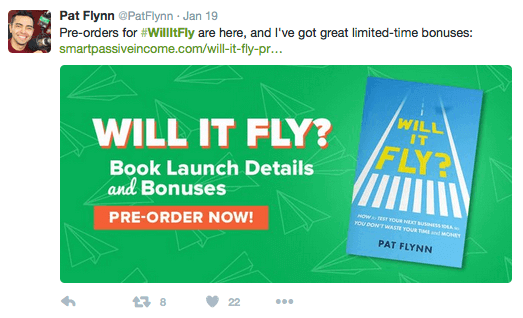

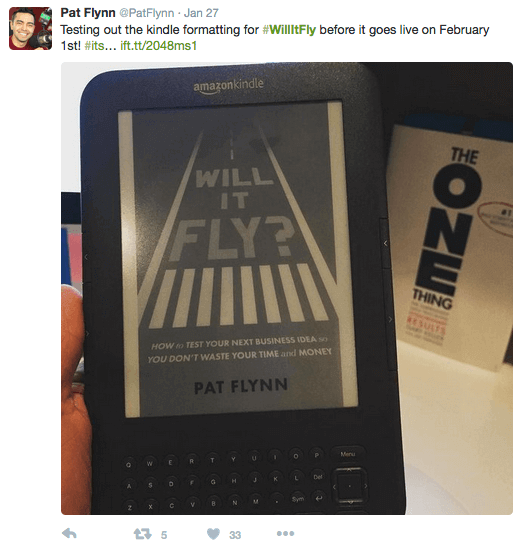
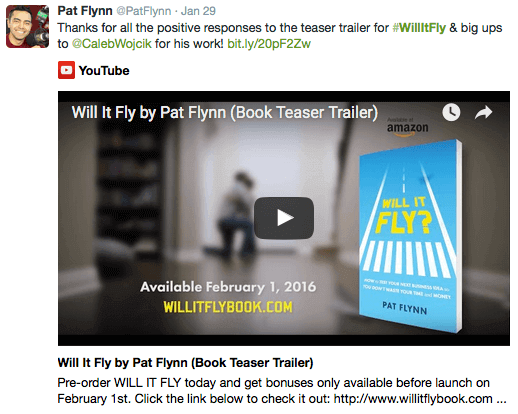
Calls to action (CTAs) are very important in marketing. Social media marketing is no different. So, as we brewed up some awesome content in our lab, we had to remain disciplined to which action we wanted Pat’s fans to take once they enjoyed the content. To stay on target, we came up with corresponding primary and secondary desired CTAs:
- Primary CTA of tweets: drive followers to book pre-order page
- Secondary CTA of tweets: drive followers to book trailer, blog post, launch team signup
By creating these initial Twitter content ideas and their corresponding CTAs, we had a strong base to start writing the tweets and plugging them into our calendar well in advance of the book launch date of February 1. (Craving to learn more about our approach to a well-organized social media campaign calendar? Feel free to jump ahead to step 4.)
2. Publish content on multiple channels in unique ways.
As I foreshadowed above, we benefited from crafting engaging content for Twitter that could then be extended in unique ways for other social media channels. We kept Twitter limited to two or three Will It Fly?-related tweets per day. Next, we took advantage of the unique attributes of Facebook, Periscope, Goodreads, and Instagram. It was important for Pat to cover a wide variety of platforms, as not all people are on every platform. Let’s dig into our channel-specific strategies, starting with Facebook.
Facebook Strategy:
Frequency is an essential component in social media promotion and marketing. You don’t want to pummel your audience with too much promotional content, or post so infrequently that they aren’t aware of what you’re trying to promote. (Want to learn about our broader application of our strategy for social media frequency? Check out the “Be mindful of frequency” section below!)
When it applies to Facebook specifically, content frequency is crucial. Data suggests that by keeping Facebook posts to once per day or even once every other day, you may see a higher reach and impression rate on those posts. In other words, engagement, or likes and shares, begins to drop off dramatically once you start posting more than once per day. Take a gander at the excellent The Social Media Frequency Guide for a detailed explanation of this.
In addition to being cognizant of the frequency of our content, we also made sure to emphasize a wide variety of relevant content, including video. Similar to images, video often garners a lot of engagement on social media. Video is exciting, aesthetically intriguing, and a visual break from long, potentially less engaging blocks of text. Plus, video (or posts with visuals in general) drives more engagement. Gloria Rand does a great job explaining in the fascinating infographic, How Visual Content Drives Social Media Growth, and further detailed here:

So, one of the things Pat did was create a few videos related specifically to Will It Fly? First, he created a short teaser book trailer and posted that on Facebook with the goal of accumulating interest for the book, motivate people to pre-order, and of course engage with the post directly. Second, he released a longer video which provided a more in-depth preview into what Will It Fly? is all about and how it can help people who have a business idea that requires a kick in the tires.
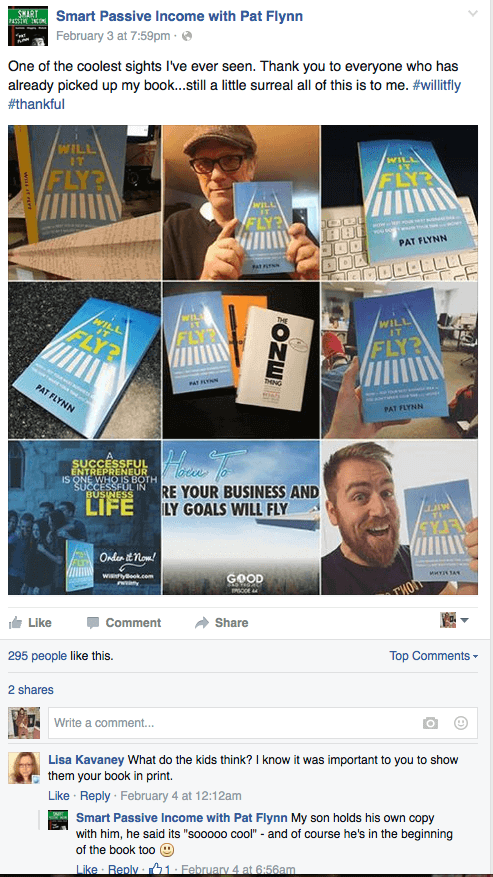
One other key element of our Facebook strategy was the Facebook Group created for the amazing Book Launch Street Team. Thankfully, we had Daniel Decker, the man behind the Will It Fly? Book Launch Street Team (see Building a Book Launch Street Team + Pre-Order with Daniel Decker (SPI 198)). Daniel was integral in building a community of people just as excited as we were for Will It Fly?, before and after launch.
For those individuals who signed up in advance of the book’s publication to be a part of the Launch Team (you guys are awesome, by the way!), you were part of a group of passionate people connecting with each other, making friendships, interacting on Facebook, and even sharing some of your favorite Will It Fly? quotes. It just goes to show that Facebook Groups can be a powerful tool to help foster community and excitement around a shared interest. Now, in addition to the content Team Flynn was producing, Daniel had fostered an amazing team who added to the promotional Will It Fly? content by tweeting their anticipation for the book launch or sharing their thoughts about the book after reading.
Periscope Strategy:
Periscope is a great way to engage with people in real-time. It served as a platform where Pat could share—genuinely and from his heart—exciting parts of the pre- and post-book launch journey. He answered questions as they came in, read parts of the book before it launched, and shared the book cover. It’s just a really fun way to engage with an excited group of people and react together in the moment. As for the frequency, Pat is pretty spontaneous with Periscope and he used it when it made sense to share his highs and lows. On Periscope? Connect with Pat!
Pat also used Periscope to leverage social proof by sharing Will It Fly? pre-order numbers and Amazon rankings. In doing so, Pat’s audience latched onto his excitement and anticipation, which can be very compelling if you are experiencing his energy live.
Goodreads Strategy:
If you’re not familiar with Goodreads, it’s basically a social media platform for book lovers—so of course we had to use it to promote Pat’s new book! We listed Will It Fly? about four weeks before launch day and made sure it was connected to Pat’s author page. We also made sure Pat’s author profile was updated with his website, bio, photo, and favorite books on his “Read/Want to Read” lists. We then asked the Street Team to post early reviews, and used the built-in blog feature to announce when the pre-order was ready, our launch day party, and when the book was officially live. Goodreads also has features for advertising and running giveaways, which we plan to take advantage of with future promotions of Will It Fly?
Instagram and Snapchat Strategy:
Remember, not everyone is on every social media channel, so we needed to promote on a variety of different platforms, and Instagram and Snapchat are places where Pat could be a little more personal and less scripted. For example, he shared a fun side-by-side image of Will It Fly? in its reveal next to an image of the A Match Made in Space book reveal in Back to the Future. He shared first on Instagram and then cross-promoted on Facebook.
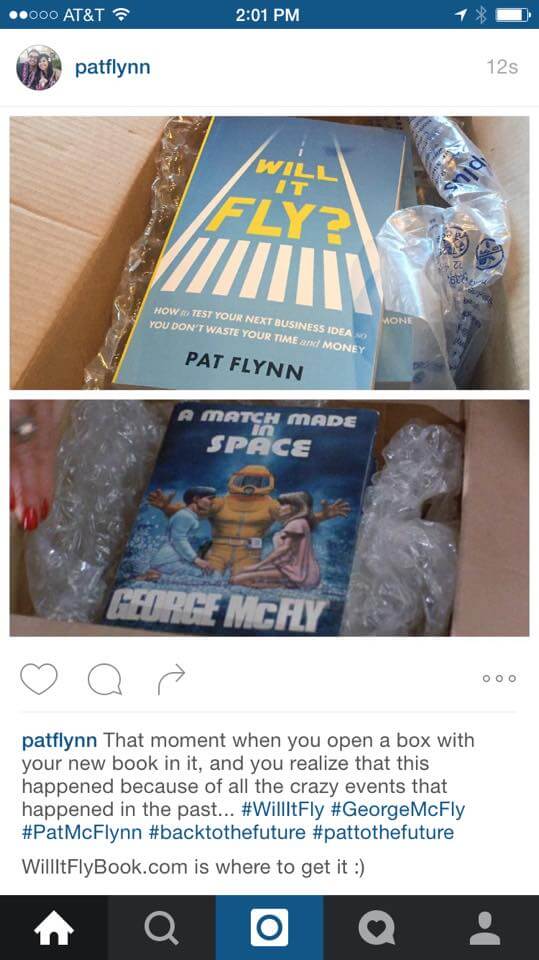
Always, always, always be real. People aren’t interested in perfection. They want to see the nitty gritty, the flaws, the toiling. They want to see your humanity. Pat used Instagram and Snapchat to share openly about the book launch journey, including both the ups and the downs. He embraced the realness by staying true to himself and engaging with his community on a human level. Check out Gary Vaynerchuk’s Community Management: Why Betting on the Human Side Works for an impressive, in-depth look into the importance of embracing the realness.
3. Be mindful of frequency.
Frequency is also a key component to any social media strategy. You want to be consistent, but not overwhelming. More human, less spam. If you know Pat, you know that there isn’t a disingenuous bone in his body. Which is to say that the content you create should be reflective of who you are, not of Spammy McTurbo Salesington. Content should be real, show your genuine self, and be inclusive of both your successes and struggles along the journey (more on this later).
So we developed a basic game plan for frequency of book launch-related content, which was then applied to our other social media efforts on Facebook and Periscope. The frequency of content took a number of things into account, including, but not limited to:
- Timing of advance book reviews
- Book cover completion
- Consistency of content
- Analytics on best times to tweet according to data from Followerwonk
- Guest appearances on podcasts
- Book launch party timing
While Twitter was our main focus, as mentioned, Pat did some essential stuff on social media platforms Facebook and Periscope, as well as some Instagram fun and advance reviews from the Book Launch Street Team on the literary wonderland that is Goodreads.
4. Drive CTAs to a single landing page that evolves to support the needs of the campaign without undermining the singular focus of the CTAs.
Each of our CTAs were driven to a single landing page: willitflybook.com. From pre-launch to post-launch social media strategy, we made sure that the content, and the CTAs that supported the content, was unique and fresh. In addition, as the content evolved, so did the landing page. Willitflybook.com transitioned from an informational page where interested people could sign up to be the first to hear about Will It Fly? to a robust pre-order page with engaging graphics to the Amazon page where you can purchase the book directly (currently the Kindle version is #1 and the print version is #2!)
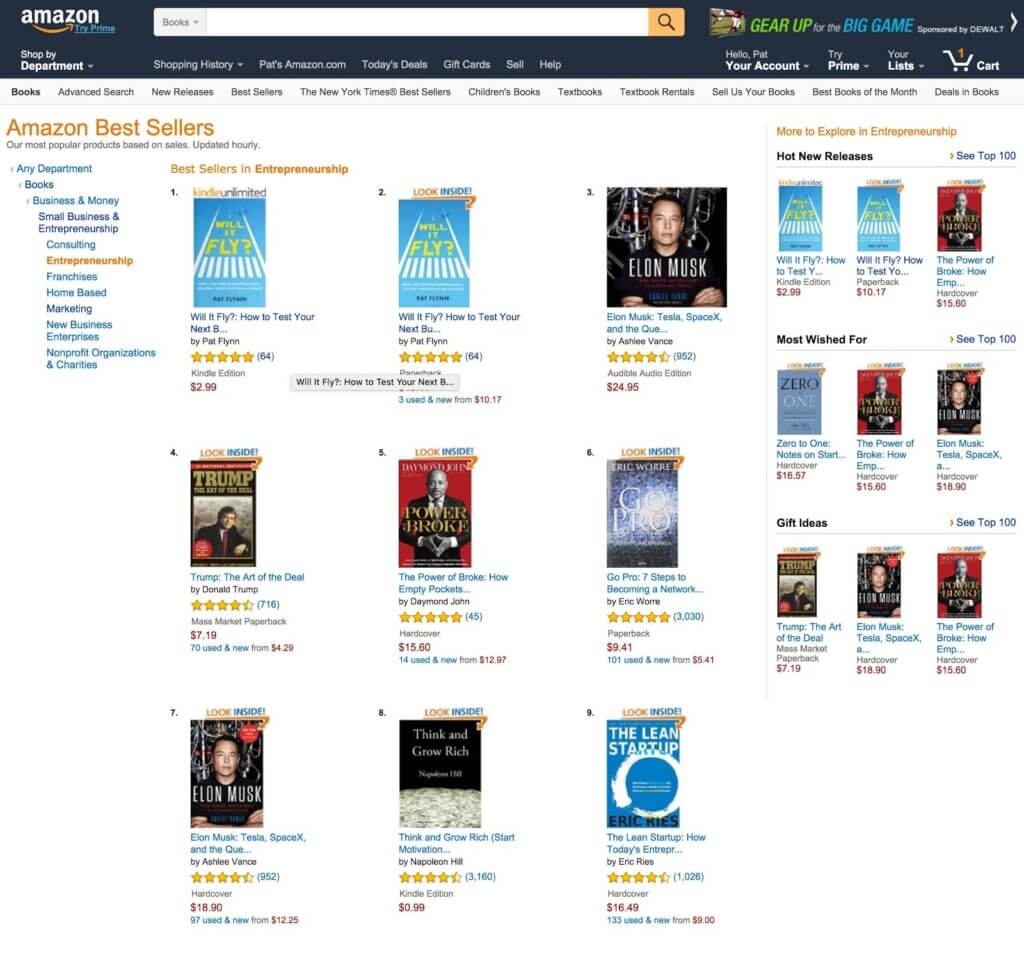
Step 3: Executing on the Strategies
After all of our strategizing and planning, it was finally time for execution—the actual writing and scheduling of posts. Here’s a look at our execution process.
1. Creating social media content specific to Twitter, Facebook, Periscope, and Goodreads.
With our initial content ideas and social media platform-specific strategies, we were able to fully develop our tweets, Facebook posts, and so on. And, because we created social media content throughout the launch journey, from pre-launch to present, we needed a powerful, user and web-friendly calendar we could edit and add to quickly. When you’re developing a social media strategy, a calendar is essential.
For the Will It Fly? social media strategy, we used CoSchedule, a tool that serves as a social media content scheduler (with color coding so we could differentiate Twitter posts from blog posts), workflow manager, the nifty calendar, and so much more. But a nifty calendar isn’t always necessary. We started with a simple Google spreadsheet, which allowed us to compose tweets and easily see when we planned to post them:

To fill the calendar, we first came up with a list of essential dates starting eight weeks before the February 1 launch date. The eight weeks provided us ample time to coordinate as a team, develop and refine social media content, strategize on adding diversity to our approach, and be more aptly capable of anticipating things (e.g., a last-minute opportunity for Pat to promote Will It Fly? on another podcast) that could potentially arise.
We looked at weekly milestones that we’d promote on all of Pat’s channels, including this blog, the SPI podcast, and SPI TV. Content included episodes of the Smart Passive Income podcast delving into Behind the Scenes of Writing Will It Fly? (SPI 197) and Building a Book Launch Street Team + Pre-Order with Daniel Decker (SPI 198) and Pat’s guest spots with something like 25 other podcasters, including folks like Hal Elrod and Amy Porterfield. (A complete list of Pat’s podcasts appearances can be found here.)
We also continued to add essential dates and promotional opportunities leading up to the launch that would align with the overall social media strategy and give us the best chance to meet our primary goals. All these dates we added to our calendar.
2. Enriching the social media content experience with on-brand graphics in addition to text.
Images and graphics do a lot to enhance social media messages. They are often engaging, visually interesting, attention-grabbing, and used to support the text around it. In the case for the Will It Fly? social media strategy, Team Flynn created a number of great images that helped to to enrich the experience for Pat’s community.
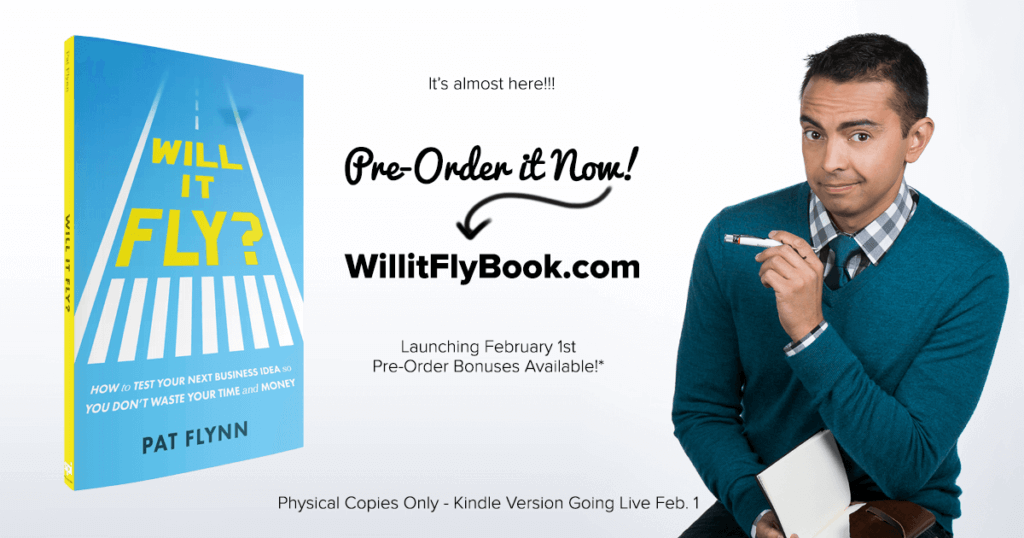
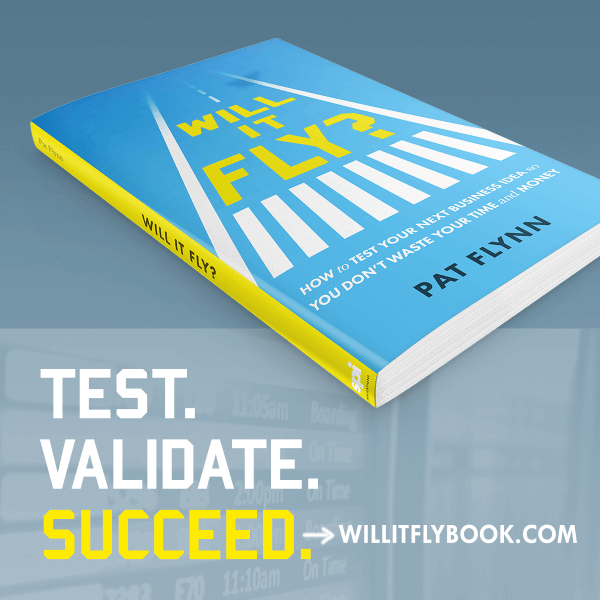
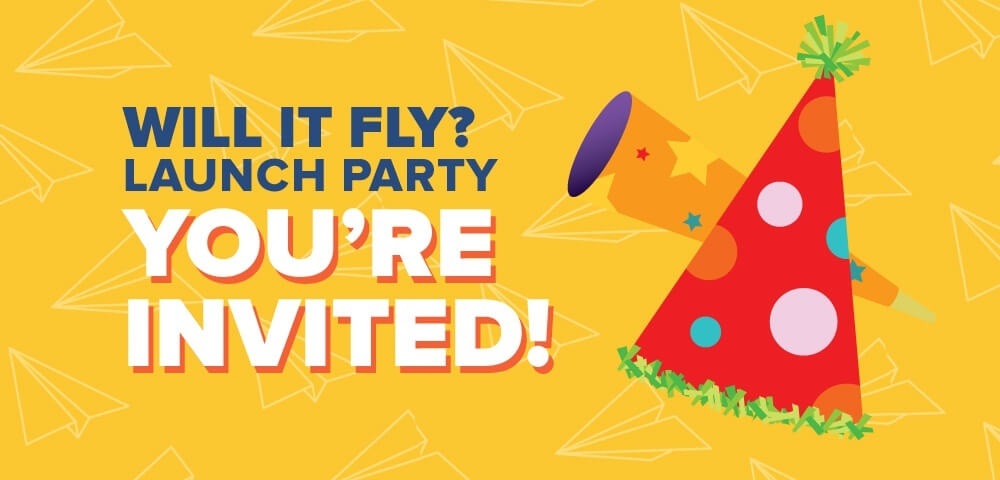
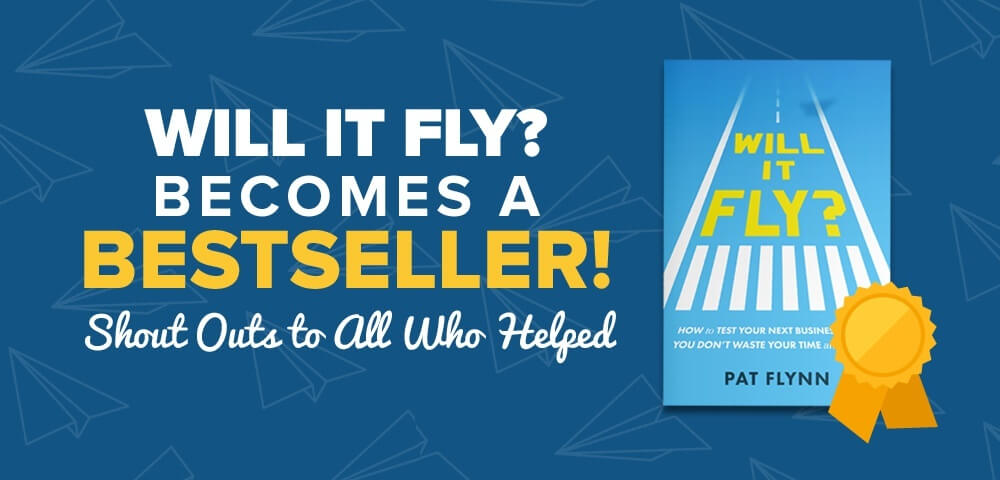
Not only do these images help to reinforce key points of our strategy—pre-orders, launch date, theme of the book—but also they keep the visual of the book cover in front of Pat’s audience, generating even more excitement for its release.
3. Building an engaged and supportive Street Team.
As previously mentioned, word-of-mouth can be a pretty powerful tool. But you need people to make it work. With the help of Daniel Decker of Higher Level Group, we had a wholehearted, engaged, passionate Street Team eager to promote Will It Fly? The best part was that they truly wanted to be a part of the book launch journey from start to finish.
Daniel was instrumental in organizing this team. He helped us recruit team members, via an opt-in survey form that Pat sent to his email subscribers and made available on his blog and podcasts. Once the team of 500+ people was assembled, Daniel used the private Facebook group to keep their energy pumped by sharing things like a welcome video from Pat, quotes and images that the they could use on their own social media profiles, and previews of the book cover including early concepts before it was finalized.
The team’s excitement was pretty incredible to see. Some of which is represented here:

4. Interacting with fans on social media during promotional events like the launch day webinar.
On Will It Fly? launch day, an exhausted and eager Pat hosted a 90-minute webinar for both Periscope and Google Hangout communities, to bring everyone together and share in excitement for the book. During the 90 minutes, Pat thanked special members of Team Flynn, answered thoughtful questions that came in from both social media platforms, chatted with call-in guests (including one from Joey Korenman, Founder of School of Motion), shared insights on the book launch process, and gave away some goodies.
Many people who attended had been following Pat’s journey of writing and publishing Will It Fly? via all of this social media strategy we’ve been talking about, and they were even more excited for an opportunity to see Pat and interact with him live on launch day. One fun fact: the Kindle version of the book was delayed for availability in the Kindle store, which Pat explains in the video. Throughout the event, he kept refreshing to see if the status had changed. It does change from “in review” to “publishing” and you can watch Pat’s reaction around the 1:22 mark.
Click on the image below for the full replay of the Will It Fly? launch day webinar:
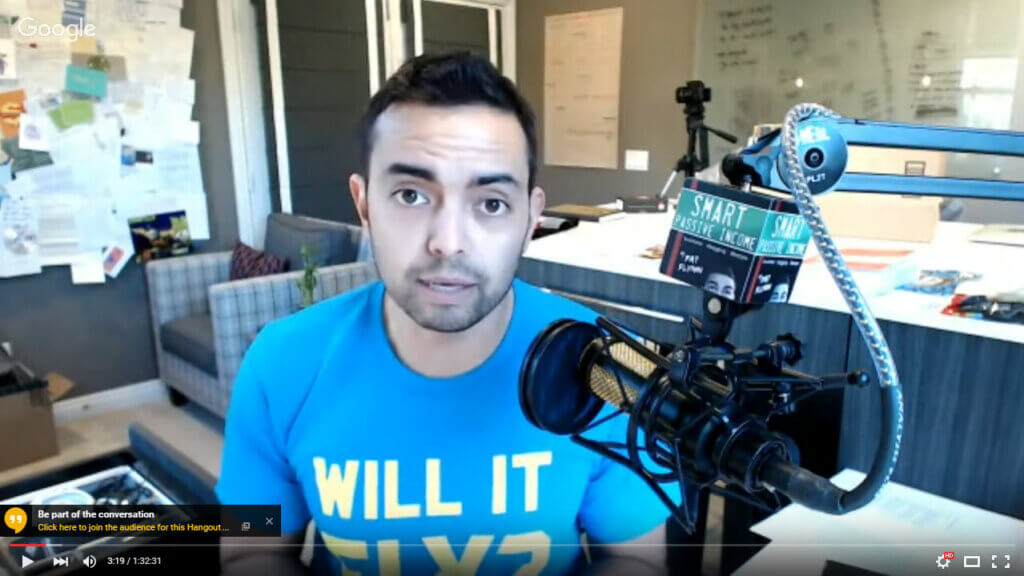
Well, that does it for the peek inside the Will It Fly? social media strategy. Before I sign off, I wanted to thank you for everything you’ve done for this book launch journey—the excitement you’ve reciprocated, the joy you’ve shared. It’s wonderful. To Pat and to all of us in the Pat-verse, we believe that community is so essential. If you weren’t excited about Will It Fly?, all of this strategy wouldn’t have mattered. By being open and wholly genuine about the entire process of launching Will It Fly?, and by being consistent in his engagement, Pat naturally fostered an eagerness in his community. So, the lovely and impassioned community (you folks!) really was part of the book launch journey, which is just so awesome. Without that eagerness and excitement for every facet of the journey, from behind-the-scenes writing updates to the wild insanity of anticipating Amazon rankings, Will It Fly? would not be what it is today. So, thank you!
I sincerely hope this peek inside the Will It Fly? social media Strategy helped for whatever you’re working on promoting—your book launch or your business unveiling or your new product reveal, the Doc Brown doggy chew toys you’ve delightfully named “Great Scotty Dogs.”
Thanks so much for reading!
Non (like “known”)
 Nōn Wels
Nōn Wels
 Onibalusi Bamidele
Onibalusi Bamidele

